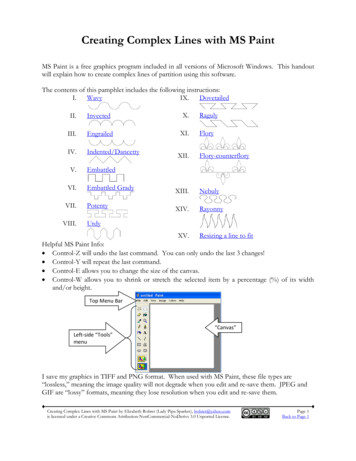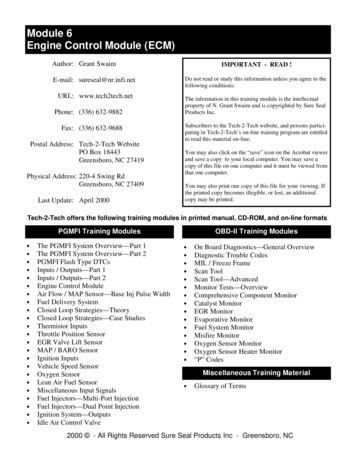
Transcription
This article appeared in a journal published by Elsevier. The attachedcopy is furnished to the author for internal non-commercial researchand education use, including for instruction at the authors institutionand sharing with colleagues.Other uses, including reproduction and distribution, or selling orlicensing copies, or posting to personal, institutional or third partywebsites are prohibited.In most cases authors are permitted to post their version of thearticle (e.g. in Word or Tex form) to their personal website orinstitutional repository. Authors requiring further informationregarding Elsevier’s archiving and manuscript policies areencouraged to visit:http://www.elsevier.com/copyright
Author's personal copyEnvironmental and Experimental Botany 67 (2009) 164–171Contents lists available at ScienceDirectEnvironmental and Experimental Botanyjournal homepage: www.elsevier.com/locate/envexpbotSoil salinity and drought alter wood density and vulnerability to xylemcavitation of baldcypress (Taxodium distichum (L.) Rich.) seedlingsVolker Stiller Department of Biological Sciences, Southeastern Louisiana University, SLU Box 10736, Hammond, LA, USAa r t i c l ei n f oArticle history:Received 13 January 2009Received in revised form 5 March 2009Accepted 18 March 2009Keywords:Soil salinityDroughtWood densityXylem cavitationTaxodium distichumBaldcypressa b s t r a c tWe investigated the role of hydraulic conductivity, wood density, and xylem cavitation in the responseof baldcypress (Taxodium distichum) seedlings to increased soil salinity and drought. One-year-old,greenhouse-grown seedlings were irrigated daily with a 100 mM ( 6‰) salt solution or once per weekwith fresh water (drought). Controls were irrigated daily with fresh water. Gas exchange rates of stressedplants were reduced by approximately 50% (salt) and 70% (drought), resulting in a 50–60% reduction indiameter growth for both treatments. Stem-specific hydraulic conductivity (KS native ) of stressed plants was33% (salt) and 66% (drought) lower than controls and we observed a strong positive correlation betweenKS native and gas exchange. In addition, we found a strong relationship between CO2 assimilation rate (A) andthe soil-to-leaf hydraulic conductance (kL ). The relationship was identical for all treatments, suggestingthat our moderate salt stress (as well as drought) did not affect the photosynthetic biochemistry of leaves,but rather reduced A via stomatal closure. Lower KS native of stressed plants was associated with increasedwood density and greater resistance to xylem cavitation. Xylem pressures causing 50% loss of hydraulicconductivity (P50 ) were 2.88 0.07 MPa (drought), 2.50 0.08 MPa (salt) and 2.01 0.04 MPa (controls). P50 s were strongly correlated with wood density (r 0.71, P 0.01) and KS native (r 0.74, P 0.01).These findings support the hypothesis that there is a significant trade-off between a plant’s cavitationresistance and its hydraulic efficiency. The results of the present study indicate that stressed plants partitioned their biomass in a way that strengthened their xylem and reduced vulnerability to xylem cavitation.Hence, these seedlings could be better suited to be planted in environments with elevated soil salinity. Formost parameters (especially P50 ), drought had an even more pronounced effect than salinity. This is important as nurseries could produce “stress-acclimated” seedlings simply by reducing irrigation amounts andwould not have to contaminate the soils in their nursery beds with salt applications. 2009 Elsevier B.V. All rights reserved.1. IntroductionIt is a well-established fact that plant survival and growth ishighly dependent on water availability and unimpeded water transport (i.e. water availability to the leaves) in order to maintainphotosynthesis and growth. According to the cohesion–tensiontheory (Dixon, 1914; Tyree, 1997; Steudle, 2001), plants transportwater under negative pressure, which makes this mechanism inherently susceptible to cavitation and xylem dysfunction (Tyree andSperry, 1989; Sperry et al., 1993). Numerous studies have showncavitation to occur in roots (Alder et al., 1996; Linton and Nobel,1999; Sperry and Hacke, 2002; Sperry et al., 2002; Domec et al.,2006), stems (Sperry and Tyree, 1988; Cochard, 1992; Hargrave etal., 1994; Hacke and Sauter, 1995; Jarbeau et al., 1995), and leaves(Salleo et al., 2001; Stiller et al., 2003; Nardini et al., 2003). While, Tel.: 1 985 459 2493; fax: 1 985 549 3851.E-mail address: vstiller@selu.edu.0098-8472/ – see front matter 2009 Elsevier B.V. All rights ative studies show that, within species and/or individualplants, roots are generally more vulnerable to water stress inducedcavitation than stems (Sperry and Saliendra, 1994; Jackson et al.,2000; Matzner et al., 2001), the overall degree of cavitation resistance is generally correlated with the species’ habitat (Davis etal., 1998, 1999; Hacke et al., 2000; Pockman and Sperry, 2000;Jacobsen et al., 2007a,b). However, large differences in cavitationresistance in co-occurring species have been reported (Kolb andDavis, 1994).Recently, studies have suggested that cavitation resistance isdetermined by wood anatomical and biomechanical parameters,such as wood density, modulus of rupture, and the resistance toconduit implosion (t/b)h 2 (Hacke et al., 2001a; Jacobsen et al.,2007b,c; Pratt et al., 2007). While the evolutionary and functionallinks between xylem properties, cavitation resistance, water use,and plant distribution are currently debated (Maherali et al., 2004,2006; Jacobsen et al., 2007a), it is generally accepted that plantsfrom xeric habitats have denser wood and are less vulnerable toxylem cavitation than plants from mesic habitats (Tyree et al., 1991;
Author's personal copyV. Stiller / Environmental and Experimental Botany 67 (2009) 164–171Kolb and Davis, 1994; Sperry, 1995; Pockman and Sperry, 2000;Hacke et al., 2001a; Maherali et al., 2004).Large baldcypress tupelo swamps characterize the naturalcoastal wetlands of the southeastern United States, many of whichare threatened by increases in flooding and salinity as a resultof both natural processes and man-induced hydrologic alterations(Penland and Ramsey, 1990; Day et al., 2000; Morton et al., 2003).In addition, large areas have been clear-cut in the early 20th century (Mancil, 1980; Keddy et al., 2007). In the past, great effortshave been undertaken to restore these degraded areas. In thewetlands near Pass Manchac in southeastern Louisiana (30 17 N,90 21W) alone, almost 100,000 baldcypress seedlings have beenplanted during the past 10 years by various conservation groups(Michael Green, Southeastern Louisiana University, personal communication), however restoration success was very limited. Oneoften-cited reason for this limited success is increased soil salinity due to salt-water intrusion from the Golf of Mexico via LakesBorgne and Pontchartrain (DeLaune et al., 1987; Gornitz et al., 1982;Turner, 1991, 1997). Although considerable intraspecific variationexists, baldcypress is known to be sensitive to relatively low levels of salinity (Allen et al., 1994, 1997; Krauss et al., 2000). Studiesfound reduced germination rates (Krauss et al., 1998), gas exchange(Pezeshki, 1990; Pezeshki et al., 1995; McLeod et al., 1996), rootand shoot biomass production (Allen et al., 1997; Krauss et al.,1999), height growth (Conner et al., 1997; Krauss et al., 2000) andincreased tree mortality (Krauss et al., 2000). Salinity effects aregenerally exacerbated by flooding (McLeod et al., 1996; Conner andInabinette, 2003), drought (Elcan and Pezeshki, 2002; Wang andCao, 2004), anaerobic soil conditions (Pezeshki, 1990), and insectattack (Effler and Goyer, 2006). However, it is not fully understoodwhether this salt sensitivity is due to (long-term) toxicity of saltions (sodicity) or due to the effects of reduced soil water potentialon plant water status. Munns (2002) reports that the short-termeffects (minutes to days) of increased soil salinity are identical tothose of drought. The author continues to argue that this indicatesthat short-term salinity effects are probably due to factors associated with water stress rather than a salt-specific effect and thatthe observed growth reduction is presumably regulated by hormonal signals coming from the roots (Munns, 2002, and referencestherein).We conducted a preliminary greenhouse study and found 8week-old apical shoots of baldcypress seedlings highly vulnerableto xylem cavitation (P50 1.23 MPa, see Section 2 for details onP50 ). Hence, if the soil water potential is lowered sufficiently by saltwater, young shoots of seedlings planted in saline environmentswould suffer greatly from xylem cavitation and seedlings could dieback. The objective of the present study was to evaluate vulnerability to xylem cavitation of baldcypress seedlings grown underelevated soil salinity and under drought conditions. In particular,we wanted to answer the questions whether (a) our treatmentswould increase the plants’ wood density, which could be associated with more cavitation resistant plants and (b) whether droughtand salinity trigger a comparable response. The results of this studycould aid efforts to produce more cavitation resistant baldcypressseedlings that are better suited to be planted in environments withelevated soil salinity.2. Materials and methods2.1. Plant material and growth conditionsOne-year-old, bare-rooted baldcypress seedlings were obtainedfrom the Louisiana Department of Agriculture & Forestry (BatonRouge, LA, USA) and grown in 15-L pots under ambient conditions (approximately 34/24 C, 50/80% relative humidity, day/night)165in a greenhouse at Southeastern Louisiana University. Soil wasfritted clay (Balcones Mineral Corporation, Flatonia, TX, USA) supplemented with Osmocote 13-13-13 slow release fertilizer (TheScotts Company LLC, Marysville, OH, USA).During the first 8 weeks of seedling establishment, all plantswere irrigated frequently to avoid drought stress. After plants wereestablished they were divided into 3 groups. Control plants werewatered twice daily, drought plants were watered once per week,and plants subjected to a salinity treatment were irrigated twicedaily with salt solution. The concentration of the salt solution wasgradually raised over a 4-week period from 35 to 100 mM ( 2–6‰,measured with YSI 30/10FT; YSI Incorporated, Yellow Springs, OH,USA) and was then kept constant at approximately 100 mM for theremainder of the experiment. To avoid salt build-up in the soil,plants of the salinity treatment were heavily watered with freshwater once per week.Basal stem diameters were measured at the beginning of thetreatments (May), in the middle of the growing season (August),and at the end of the growing season when plants were harvestedfor hydraulic measurements (November). Relative diameter growthrates were calculated for the first and second half of the growingseason (RGRMay–August and RGRAugust–November , respectively), as wellas for the entire season (RGRMay–November ).2.2. Soil-to-leaf hydraulic conductance (kL )In the middle of the growing season and at the height of theweekly drought stress, CO2 assimilation rate (A), transpiration rate(E), and stomatal conductance (gS ) of young, fully expanded leavesof 11 representative plants from each treatment was measuredusing a LI-6400 photosynthesis system (LI-COR Inc., Lincoln, NE,USA). Afterwards, the leaf area inside the cuvette was measuredwith a LI-3100 Area Meter in order to correct the gas exchangedata for leaf area. Midday leaf water potential was measured witha Scholander type pressure chamber (PMS Instrument Company,Albany, OR, USA) on comparable leaves of the same plants. Soilwas sampled directly from the root zones through vertical slits in3 representative pots for each treatment. Soil samples were pooledand soil water potentials were measured after a 15 min temperature equilibration period using a WP4-T Dewpoint PotentiaMeter(Decagon Devices, Pullman, WA, USA). Soil-to-leaf hydraulic conductance of the plants (kL ) was calculated askL soilE leafwhere E is the transpiration rate of the plants andpotential of the soil or the leaves.is the water2.3. Xylem cavitation vulnerability curvesAt the end of the growing season, all treatments were irrigatedwith fresh water twice daily for one week to allow stressed plantsto recover and to minimize native embolism. Ten representativeplants from each treatment were harvested and their vulnerability to xylem cavitation was measured. Vulnerability curves showthe relationship between xylem pressure and the percentage loss ofhydraulic conductivity (PLC) associated with this pressure. The vulnerability curves were measured using the centrifugal force method(Alder et al., 1997) on 0.14 m stem segments cut under water fromcurrent-year growth. Before stems were flushed at 70 kPa for 30 minwith deionized and filtered (0.2 m) water to remove any nativeembolism, native hydraulic conductivity (Knative ) was measured andstem-specific native conductivity (KS native ) was calculated basedon the segments cross-section area. After flushing the maximumhydraulic conductivity (Kmax ) was measured. The percentage thatKnative was below Kmax gave the segment’s native PLC ( native
Author's personal copy166V. Stiller / Environmental and Experimental Botany 67 (2009) 164–171embolism). Kmax values of several stems were between 1% and3% below Knative , indicating not only a lack of native embolism,but also that flushing caused minor torus aspiration. We, therefore, used the unadulterated KS native in Figs. 2 and 4, as it reflectsthe true hydraulic conductivity better than Kmax . The flushed stemsegments were exposed to progressively more negative pressuresby spinning them in a custom-built centrifuge rotor in a SorvalRC5B centrifuge. Segments were spun for 4 min at each pressure tosaturate the embolism response. The K was remeasured betweeneach pressure and the PLC (relative to Kmax ) associated with eachpressure was recorded in a vulnerability curve. Generally, 6–7 Kvalues were measured per stem. To estimate the pressure causing 50 PLC (P50 ), a Weibull function (Neufeld et al., 1992) wasfitted to each segment’s vulnerability curve and solved for P50 .After hydraulic measurements were complete, stem segments werestored in a freezer until wood density measurements could bemade.2.4. Wood density and specific leaf areaStems used for hydraulic measurements were thawed and 2 cmsegments were cut from the basal end. The bark of these short segments was removed and the segments were hydrated over nightin deionized water. The next day, the fresh volume (VF ) of the segments was measured by carefully submerging them in a beaker ofwater (placed on an electronic balance, Sartorius LE225D, SartoriusAG, Göttingen, Germany) and noting the weight of the displacedwater. This procedure was repeated 3 times and the volume wascalculated from the mean of the 3 measurements. Segments wereoven-dried at 85 C for 48 h and dry mass (mD ) was measured. Toensure weight consistency, segments were dried for an additional24 h and the mass remeasured. Wood density ( w ) of the segmentswas calculated as w mDVFMultiple leaves were sampled from 13 salt and 21 drought andcontrol plants prior to harvesting stems for hydraulic measurements. Leaf area (AL ) was measured with a LI-3100 Area Meter(LI-COR Inc., Lincoln, NE, USA) and leaves were oven-dried asdescribed above for stem segments. Mass of the dried leaves (mL )was measured and specific leaf area (SLA) was calculated asSLA ALmL2.5. StatisticsData were analyzed with the SPSS 8.0 statistics package (SPSSInc., Chicago, IL, USA) using the 0.05 and 0.01 significance levels.Comparisons were made with a one-way ANOVA and Tukey’s HSDtest for a posteriori comparisons between means of all treatments.Significance of relationships between means that were measuredon different plants and at different times (Fig. 2) were tested viacontrast analysis following a one-way ANOVA.3. ResultsAfter the initial seedling establishment phase, basal diametersof the plants were similar (Table 1). During the first 3 months ofgrowth, relative growth rates of control plants were approximatelytwice the rates of salt and drought treatments, resulting in significantly larger controls. During the second half of the growing season,growth rates of plants irrigated with salt solution were greatlyreduced. Growth rates of controls were only slightly lower compared to the first half and drought plants did not alter their growthrates significantly. The pronounced growth reduction of salt plantswas reflected in an early onset of senescence in mid-October, whiledrought and control plants did not senesce. (Surplus control anddrought plants did not enter dormancy during the winter in thegreenhouse.) Plant growth during the first half of the growing season was significantly correlated with the plants’ CO2 assimilationrate (A, Table 2). However, as the timing of the gas-exchange measurements was designed to maximize the effects of drought (2 hafter salt and control plants were irrigated and 1 h before the weeklyirrigation of drought plants), the correlation of the two parameterswas relatively weak (r 0.36, P 0.05, data not shown).Gas-exchange of salt and drought plants was significantlyreduced when compared to controls (Table 2). While this reduction seemed most pronounced in drought plants, drought and salttreatments were not different at the P 0.05 level. However, Awas different at the P 0.06 level (indicated by italicized lettersin Table 2). Midday leaf water potentials ( leaf ) of all three treatments were significantly different, with drought plants having themost negative and controls having the least negative leaf . Soilwater potential ( soil ) of salt and control plants were 0.93 and 0.34 MPa, respectively. The osmotic potential of the salt solutionused for irrigation was approximately 0.5 MPa. Interestingly, after7 days without irrigation, soil of drought plants was less negativethan expected ( 0.64 MPa). Still, this water potential was sufficiently low to result in an almost 5-fold reduction of soil-to-leafhydraulic conductance (kL ) for drought plants compared to controls and salt plants. As native embolism was not measured at thetime of gas-exchange measurements, we were unable to establish xylem cavitation as the cause for the kL reduction in droughtplants. However, there was no native embolism in any treatmentat the end of the growing season when hydraulic measurementswere made. Stomatal conductance (gS ) as well as transpirationrate (E) and kL are auto-correlated. Therefore, only the relationshipbetween A and kL , which were measured independently is shownin Fig. 1. Absolute values of A and kL were closely related in alltreatments (r2 0.79, r2 0.76, and r2 0.73, P 0.01, for drought,salt, and control plants, respectively; Fig. 1 solid lines). When thepooled data of all three treatments was examined, the relationship between A and kL seemed to follow a saturation curve, with alinearly increasing lower region (mainly drought plants) followedTable 1Basal stem diameters of one-year-old baldcypress seedlings at the beginning of treatments (DMay ), in the middle of the growing season (DAugust ) and at harvest time (DNovember ).Relative daily diameter growth rates were calculated for the first and second half of the growing season (RGRMay–August and RGRAugust–November , respectively), as well as for theentire season (RGRMay–November ). All diameter means and all growth rates were compared with each other. Different letters indicate homogeneous sets of means determinedwith a Tukey’s HSD test after a one-way ANOVA tested significant at the 0.05 level. Sample sizes were n 19 for salt treatment and n 25 for drought and control plants.Stem diameter May (DMay ), mmStem diameter August (DAugust ), mmStem diameter November (DNovember ), mmRelative diameter growth rate (RGRMay–August ), mm mm 1 d 1Relative diameter growth rate (RGRAugust–November ), mm mm 1 d 1Relative diameter growth rate (RGRMay–November ), mm mm 1 d 1SaltDroughtControl12.0 0.45a b15.5 0.47c d16.3 0.55c d(3.5 0.3) 10 3 a(0.6 0.1) 10 3 e(2.0 0.1) 10 3 b11.5 0.29a14.1 0.39b c17.2 0.48d(2.6 0.3) 10 3 a b(2.3 0.1) 10 3 a b(2.8 0.2) 10 3 a b11.2 0.38a17.3 0.58d25.6 0.72e(6.6 0.5) 10 3 c(5.1 0.2) 10 3 d(7.3 0.4) 10 3 c
Author's personal copyV. Stiller / Environmental and Experimental Botany 67 (2009) 164–171167Table 2Gas exchange parameter (A, E, gS ), water potential ( leaf , soil ), soil-to-leaf hydraulic conductance (kL ), and average and specific leaf area (AL , SLA) of bald cypress seedlings.Stem-specific hydraulic conductivity (KS native ), wood density ( w ), and P50 of present-year stem segments used in hydraulic measurements. The timing of the gas-exchangemeasurements was designed to maximize the effects of drought on kL . Values are mean SE. Sample sizes for A, E, gS , leaf and kL were n 11 for all three treatments. Samplesizes for w , DS , KS native , and P50 were n 10 for salt and drought treatments and n 9 for control plants. AL and SLA sample sizes were n 13, 21 and 21 for salt, drought andcontrol plants, respectively. As soil was measured on pooled soil samples, no statistics are given for this parameter. Different letters (in a row) indicate means are significantlydifferent at the 0.05 level, Tukey’s HSD following one-way ANOVA. Italics indicate significant differences at the 0.06 level.CO2 assimilation rate (A), mol s 1 m 2Transpiration rate (E), mmol s 1 m 2Stomatal conductance (gS ), mmol s 1 m 2Midday leaf water potential ( leaf ), MPaSoil water potential, pooled ( soil ), MPaSoil-to-leaf hydraulic conductance (kL ), mmol s 1 m 2 MPa 1Average leaf area per leaf (AL ), cm2Specific leaf area (SLA), m2 kg 1Stem-specific hydraulic conductivity (KS native ), kg m 1 s 1 MPa 1Wood density ( w ), g cm 3P50 , MPaSaltDroughtControl4.6 0.76 a3.9 0.42 a84 9.4 a 1.8 0.05 a 0.934.9 0.69 a12.0 1.6 a13.3 0.4 a1.01 0.10 a0.31 0.01 a 2.50 0.08 a2.5 0.52 a2.5 0.23 a54 5.2 a 2.0 0.05 b 0.641.9 0.20 b6.4 0.5 b11.3 0.3 b0.49 0.06 b0.34 0.003 b 2.88 0.07 b9.2 0.46 b8.7 0.73 b191 22.9 b 1.3 0.03 c 0.348.8 0.84 c14.7 0.9 a14.0 0.3 a1.51 0.08 c0.27 0.01 c 2.01 0.04 cby a less steep, plateau-like region (mainly controls). We fitted anexponential rise to a maximum function (Fig. 1 dashed line) to thepooled data of all treatments [y 0.82 16.46*(1 exp( 0.103x),r2 0.87]. Forcing the curve through the origin did not changethe goodness of fit, however, fitting a function solely to thepooled data of drought and control plants improved the r2 to 0.96(curve not shown).The low kL of drought plants was reflected in the lowerstem-specific native hydraulic conductivity (KS native ) of the stemsegments used for the hydraulic measurements (Table 2). Althoughdiameters of drought and control segments were almost identical,KS native of drought plants was only one third of the controls’ KS native .The relationships between KS native and gas-exchange parameters(A, gS , E, mean values from Table 2) are shown in Fig. 2. Gasexchange and KS native were measured independently on differentplants and at different times during the study, yet contrast analysisconfirmed a highly significant relationship between the parameters(P 0.001).Leaf size of drought plants was significantly reduced (Table 2).Average leaf area per leaf (AL ) of drought plants was approximately half of that of salt or control plants. In addition, specificleaf area (SLA) of drought plants was significantly lower compared to salt and control plants. The tendency in drought plants togrow smaller, denser leaves was consistent with the plants’ woodproperties (Table 2). Wood density ( w ) of slow growing droughtplants was highest, w of controls was lowest and salt plantshad intermediate w . These trends in w matched the significantdifferences in vulnerability to xylem cavitation. Fig. 3 shows vulnerability curves for current-year stem segments. Curves for all threetreatments were significantly different from each other. Stressedplants were less vulnerable to cavitation (P50 2.88 0.07 and 2.50 0.08 MPa for drought and salt plants, respectively) thancontrol plants (P50 2.01 0.04 MPa).Differences in cavitation vulnerability and in wood densitycould be a result of the plants’ growth rates. Correlation analysisFig. 1. The relationship between soil-to-leaf hydraulic conductance (kL ) andCO2 assimilation rate (A) in Taxodium distichum. Correlations for all treatmentswere highly significant (P 0.01). The r2 values within the figure are for linear regressions (solid lines). In addition to the regression analysis, we fittedan exponential rise to a maximum function (dashed line) to the pooled data[y 0.82 16.46*(1 exp( 0.103x), r2 0.87].Fig. 2. The relationship between (a) CO2 assimilation rate (A), (b) stomatal conductance (gS ) and (c) transpiration rate (E) and native hydraulic conductivity (KS native ).Mean values from Table 1. Error bars show the upper and lower boundaries of the95% confidence intervals. Sample sizes for A, gS and E were n 11 for all treatments.Sample sizes for Knative were n 10 for salt and drought treatments and n 9 forcontrol plants.
Author's personal copy168V. Stiller / Environmental and Experimental Botany 67 (2009) 164–1714. DiscussionFig. 3. Vulnerability curves of current-year stems in Taxodium distichum. Curvesshow percentage loss of hydraulic conductivity (PLC) with decreasing xylem pressure for drought (circles, n 10), salt (triangles, n 10) and control plants (squares,n 9). Means and SE (error bars are partly covered by symbols) are shown for greaterclarity; however, Weibull functions were fitted to the raw data of each treatment(solid line control, dotted line salt, and dashed line drought).revealed significant (P 0.01) correlations between P50 , w and theplants’ RGRs. While correlations were similar for all 3 RGRs presented in Table 1, the correlations with RGRMay–August was strongest.Increased RGR resulted in more vulnerable plants (r 0.61, P 0.01)and in less dense wood (r –0.63, P 0.01). Wood density hasrecently been linked to cavitation vulnerability (Hacke et al., 2001a).In general, denser wood seems to be more cavitation resistant thanless dense wood. For baldcypress, this relationship between w andP50 is shown in Fig. 4 (r 0.71, P 0.01). In conifers, denser woodcan be caused by thicker tracheid walls and/or reduced tracheidlumen per given cross-section area (Pittermann et al., 2006). Eitherwould cause a reduction in hydraulic conductivity when comparedto plants with less dense wood. In the present study, KS native andwood density of baldcypress were negatively correlated (r 0.72,P 0.01, data not shown as the figure is almost identical to Fig. 4)and the relationship between KS native and P50 is shown as an insertin Fig. 4 (r 0.74, P 0.01).Fig. 4. The relationship between P50 and wood density ( w ) of current-year stemxylem in Taxodium distichum (r2 0.50) and between P50 and stem-specific nativehydraulic conductivity (KS native , insert). Error bars indicate 1SE and are partly coveredby symbols (n 10 for salt and drought treatments and n 9 for control plants, r 0.74,P 0.01).The objective of the present study was to evaluate growth,wood density, and vulnerability to xylem cavitation of baldcypressseedlings grown under elevated soil salinity and under droughtconditions. During plant growth, care was taken to impose maximum stress on the plants without causing visible and permanentinjury to the plants. In a preliminary experiment, we found that prolonged exposure to soil salinity between 135 and 170 mM (8–10‰)caused high rates of mortality, especially when the soil was notflushed with fresh water to remove excess salt. To avoid tree mortality, we kept our salt treatments at about 100 mM (6‰), which isapproximately double the long-term salinity average but comparable to recent, drought-induced peak salinities near Pass Manchac(Thomson et al., 2002), an area in southeastern Louisiana wherecypress restoration is of especial interest.Soil salinity and drought had the same effect on a numberof parameters. Both treatments resulted in significantly reduceddiameter growth rates (RGR), gas exchange rates (A, E, gS ), stemspecific native hydraulic conductivity (KS native ) and vulnerability toxylem cavitation (P50 ). Both treatments increased the plants’ wooddensity ( w ). With the exception of second-half and entire-seasondiameter growth rates (RGRAugust–November and RGRMay–November ,respectively), drought had an even more pronounced effect thansalinity on all parameters. RGR of drought plants was reduced butconstant throughout the entire growing season (Table 1). RGR ofsalt plants was dramatically reduced during the second half of thegrowing season. This led to a low RGR for the entire season in thistreatment. This, and the early onset of senescence suggest that theremight have been additional long-term salinity effects (Tattini etal., 2002), which could lead to a reduction of photosynthesis andgrowth (Munns, 2002, and references therein), but that were notinvestigated in this study.While we did not measure leaf turnover, it was apparent during the second half of the growing season that older leaves beganto die back. The total leaf area of salt plants was reduced compared to drought plants, and even more so compared to controls.Similar reductions in total leaf biomass as a result of exposureto salinity have been previously reported for baldcypress (Allenet al., 1997), olive (Bongi and Loreto, 1989), wheat (Munns et al.,1995), and maize (Fortmeier and Schubert, 1995). However, thissalt-induced senescence was
Volker Stiller Department of Biological Sciences, Southeastern Louisiana University, SLU Box 10736, Hammond, LA, USA article info Article history: Received 13 January 2009 Received in revised form 5 March 2009 Accepted 18 March 2009 Keywords: Soil salinity Drought Wood density










